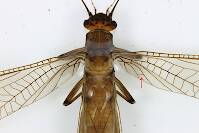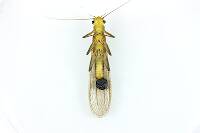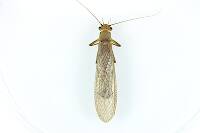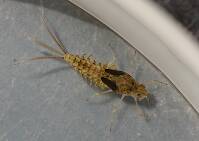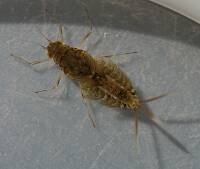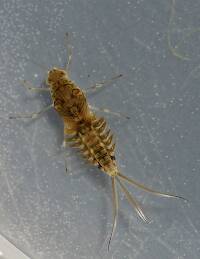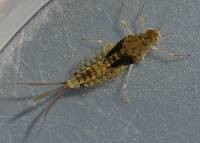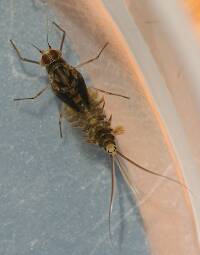
Blue-winged Olives
Baetis
Tiny Baetis mayflies are perhaps the most commonly encountered and imitated by anglers on all American trout streams due to their great abundance, widespread distribution, and trout-friendly emergence habits.
Featured on the forum

This one seems to tentatively key to Holocentropus, although I can't make out the anal spines in Couplet 7 of the Key to Genera of Polycentropodidae Larvae nor the dark bands in Couplet 4 of the Key to Genera of Polycentropodidae Larvae, making me wonder if I went wrong somewhere in keying it out. I don't see where that could have happened, though. It might also be that it's a very immature larva and doesn't possess all the identifying characteristics in the key yet. If Holocentropus is correct, then Holocentropus flavus and Holocentropus interruptus are the two likely possibilities based on range, but I was not able to find a description of their larvae.

Troutnut is a project started in 2003 by salmonid ecologist Jason "Troutnut" Neuswanger to help anglers and
fly tyers unabashedly embrace the entomological side of the sport. Learn more about Troutnut or
support the project for an enhanced experience here.
Taxon on May 23, 2009May 23rd, 2009, 3:42 am EDT
Hi Will-
Another possibility might be Siphlonurus phyllis, which I believe to be the only Siphlonurus species other than S. alternatus present in Manitoba.
Another possibility might be Siphlonurus phyllis, which I believe to be the only Siphlonurus species other than S. alternatus present in Manitoba.
Konchu on May 23, 2009May 23rd, 2009, 7:13 am EDT
what was the habitat for each one?
Willmilne on May 23, 2009May 23rd, 2009, 10:06 am EDT
Habitat - silt/clay substrate /turbid large river - 400' wide / both from the same location at the river edge in approx 2' of water on the river side of small clumps of flooded grasses.
We have S.alternatus and S.phyllis listed here , but I get the sense we may have more here than the lists suggest.
I'm probably wrong on the first one . Ventral markings are a thin central dark stripe thinner at segment 1 than 9 - broken fine dark stripe at the outer edges of segments 1-9. approx 11-12mm
Number 2 is approx 14-15 mm with no discenrable marking on the ventral side.
Couple of larger images that may help. Since I like to photography these critters live and they rarely stay motionless some details may be blurred.
http://www.watersidemb.ca/siph/siphfull1a.jpg
and
http://www.watersidemb.ca/siph/siphfull2a.jpg
Will
We have S.alternatus and S.phyllis listed here , but I get the sense we may have more here than the lists suggest.
I'm probably wrong on the first one . Ventral markings are a thin central dark stripe thinner at segment 1 than 9 - broken fine dark stripe at the outer edges of segments 1-9. approx 11-12mm
Number 2 is approx 14-15 mm with no discenrable marking on the ventral side.
Couple of larger images that may help. Since I like to photography these critters live and they rarely stay motionless some details may be blurred.
http://www.watersidemb.ca/siph/siphfull1a.jpg
and
http://www.watersidemb.ca/siph/siphfull2a.jpg
Will
Taxon on May 23, 2009May 23rd, 2009, 11:09 am EDT
Will-
Your higher resolution photos both show "abdominal segments above marked with conspicuous branched pattern", and the 1st higher resolution photo shows "a prominent brown spot on each lateral margin midway between base and apex", which is described by Justin & Fannie Leonard on page 77 of their book, Mayflies of Michigan Trout Streams, as being characteristic of Siphlonurus alternatus.
Do you have a ventral photo of the sternite markings you described on the "first" one?
Your higher resolution photos both show "abdominal segments above marked with conspicuous branched pattern", and the 1st higher resolution photo shows "a prominent brown spot on each lateral margin midway between base and apex", which is described by Justin & Fannie Leonard on page 77 of their book, Mayflies of Michigan Trout Streams, as being characteristic of Siphlonurus alternatus.
Do you have a ventral photo of the sternite markings you described on the "first" one?
Konchu on May 23, 2009May 23rd, 2009, 12:05 pm EDT
keep in mind that several spp are unknown as nymphs
Willmilne on May 23, 2009May 23rd, 2009, 1:07 pm EDT
Roger- I will make some images on Monday of the ventral markings. Not sure if it means anything but over the period I was collecting on that day .Nymph 1 outnumbered nymph 2 by a ratio of approx 6:1
I did notice comparing the two images that nymph image 1 has lateral projections on segment 10 and nymph 2 does not the plot thickens:)
Konchu - I am new to all this but beginning to understand that your statement however frustrating is very true:))
Obviously I have been taking rather portrait/dorsal views of the nymphs I have been finding. It's becoming clear to me ( I bought Merrit and Cummins and have been rummaging around on Famu) that there must be a set views that would serve to document the salient details that would be of more use than simple portraits.
What would constitute a usefull set of nymph stage images ..
Views-
Dorsal
Ventral
Profile
High magnification mouth parts
I know there are sampling protocols are there imaging protocols???
Will
I did notice comparing the two images that nymph image 1 has lateral projections on segment 10 and nymph 2 does not the plot thickens:)
Konchu - I am new to all this but beginning to understand that your statement however frustrating is very true:))
Obviously I have been taking rather portrait/dorsal views of the nymphs I have been finding. It's becoming clear to me ( I bought Merrit and Cummins and have been rummaging around on Famu) that there must be a set views that would serve to document the salient details that would be of more use than simple portraits.
What would constitute a usefull set of nymph stage images ..
Views-
Dorsal
Ventral
Profile
High magnification mouth parts
I know there are sampling protocols are there imaging protocols???
Will
Taxon on May 23, 2009May 23rd, 2009, 1:16 pm EDT
Will-
Please re-read my above post, which I was busy updating at the same time as your made your above post.
Please re-read my above post, which I was busy updating at the same time as your made your above post.
Willmilne on May 25, 2009May 25th, 2009, 8:30 am EDT
Taxon on May 25, 2009May 25th, 2009, 9:47 am EDT
Will-
Your ventral view of nymph 1 reveals markings extremely similar to those illustrated for Siphlonurus rapidus on page 79 of Mayflies by Knopp and Cormier.
Your ventral view of nymph 1 reveals markings extremely similar to those illustrated for Siphlonurus rapidus on page 79 of Mayflies by Knopp and Cormier.
Quick Reply
Related Discussions
Topic
Replies
Last Reply
6
Apr 14, 2013
by Troutnut
by Troutnut
1
Jun 5, 2007
by Quillgordon
by Quillgordon
9
Jun 17, 2015
by Oldredbarn
by Oldredbarn






